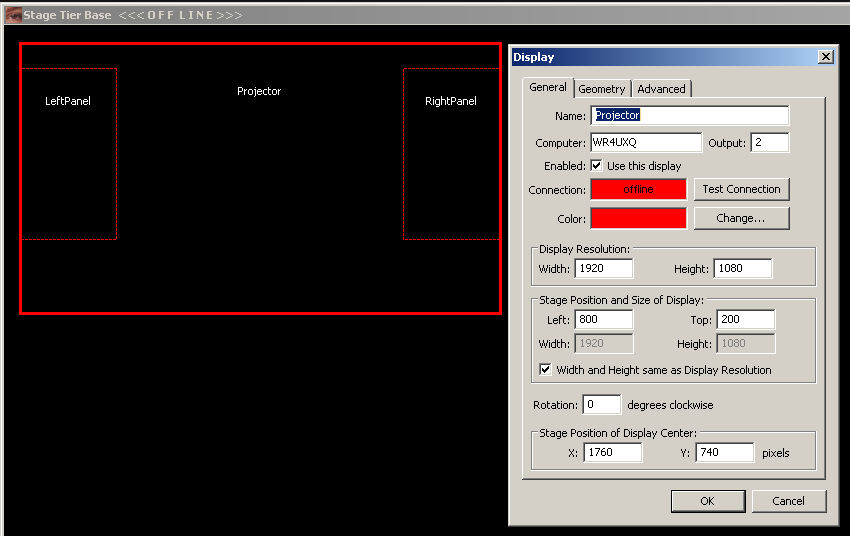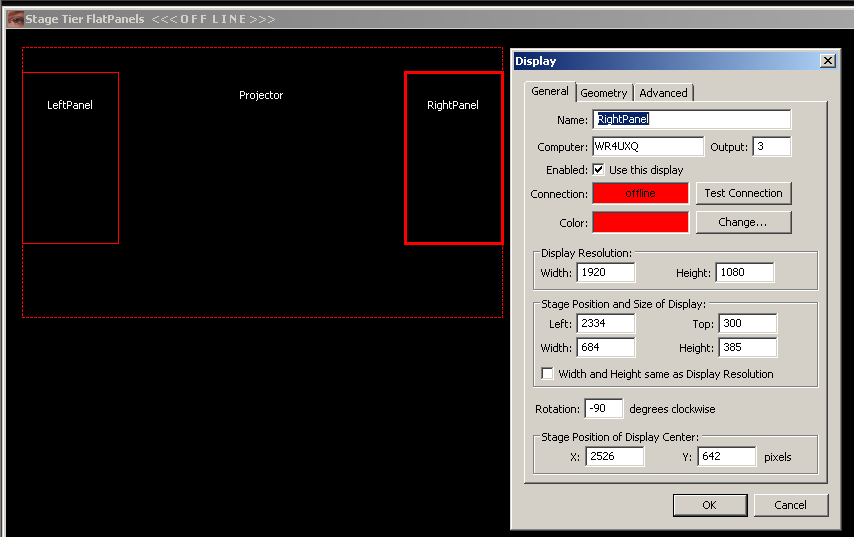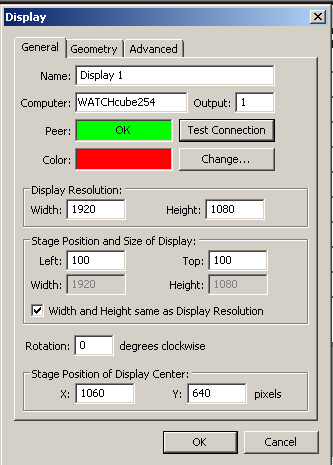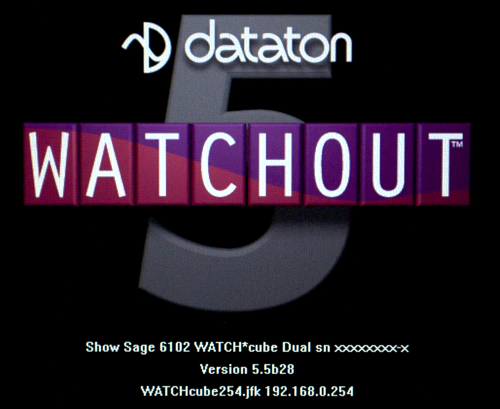-
Posts
1,810 -
Joined
-
Last visited
Posts posted by jfk
-
-
A little bit more than that, but essentially correct for still image files.
And that is why still image file format has no impact on playback performance,
all files are converted to the common uncompressed form prior to playback.
0 -
Hi. I want to control the shutter of my projector (panasonic dw6300) via rs232 in WO.
This all works good with a desktop pc, but for this project I want to use the watchpax.
Now this does not have a rs232 port, so can I use an usb-rs232 adapter?
No, you can not.
Would it work with any converter or are any specific supported?
No.
I'm assuming I can't install any drivers etc. on the pax.. does this work at all?
That is the reason, WATCHPAX is 0 config so you can not add any drivers and no USB serial drivers are present.
Probably the only way this can be done is with an IP to serial converter running on the network
and use an Output String object set to Network Port (TCP or UDP).
0 -
... The file plays fine on one screen without blending or scaling. ...
Could you clarify that? i.e. it plays fine in WATCHOUT on one screen without blending or scaling or in a media player?
(media players use hardware accelerated movie decoding, watchout uses software decoding, so that is an apples to oranges comparison.)
0 -
... When updating is the .watch file located in the displays by any chance ? ...
Yes it is, so the last successful update under that show name will be available from the display computers.
Go to the display machine, find the Shows folder and inside will be another folder with the actual show name.
Inside that folder is a file called Spec, with that file, see Rebuild show file?
0 -
Flat panel calculations
Convert to feet to keep all dimensions in the same unit measure.
34-8/32" = 34.25" = 2.854166667'
60-26/32" = 60.8125" = 5.067708333'
since the panel is rotated 90°
1920 / 5.067708333' = 378.8694758 pixels per footprojection — 8'H consists of 1080 pixels = 135 / pixels per foot.
90° rotated 1080-p flat panel — 5.068' W consists of 1920 pixels = 379 / pixels per foot
379 / 135= 2.806440562, a correction factor inside of 300%1920/2.8 = 684 (684.140625)
1080/2.8 = 385 (384.8291016)
The projector stays native at 1920 x 1080 stage size,
The flat panels 1920x1080 output become 684 x 385 stage size.
To do this correctly, you would also need the measurement from flat panel image edge
to the corresponding edge of the actual projected image (not your cropped image).
And you would need the distance from the top of the projected image to the top of the flat panel images.
You may have to use stage tiers to deal with that.
The stage Display dialogs may end up looking something like this ...


 0
0 -
The physical size of the screen is 8 feet X 8 feet. The monitors are fully visible.
You are missing the point.
- Please provide the exact hight and width dimensions of the projected size of the full 1920x1080 raster. In a pinch, you can get by with just height.
What you crop out of it after that is not important to the calculation.
- Please provide the exact height and width of the visible area of the flat panel.
- Please provide / confirm the exact resolution of the flat panels.
With that information you can calculate
the number of pixels per unit measure (dpi) for each display type.
Then, you can calculate the correction
to make an image spanning both display types remain the same actual size.
Open the Stage Display Dialog
Uncheck Width and Height same as Display Resolution and
Lock down the Display Resolution at the display's native pixel count.
You then convert the above correction to stage size in pixels to achieve the desired result.
0 -
... We plan on blacking out the edges of the projection to prevent projection bleed, but as far as Watchout stage set-up how do I set up the center screen? Do I use the final 8X8 foot size or 1920X1080 pixel size? (Imagery will be flowing across the screens.)
The projector still expects a 1920x1080 signal. So you still need to output 1920x1080,
use a pair of simple black still images on the top layer (or on an aux timeline set to always on top)
to mask the unused portions of the raster.
There is a chance the pixel density difference between the flat panels and the projected images
is outisde the magnification correction range of WATCHOUT (±300%),
not enough info to make that determination.
0 -
... Is there any equivalent command in the Production Computer Protocol for shutting down a computer running the Watchout Production software?...
No.
But why? If there is no human to shut down production, why are you using production at all?
Short of a human being making edits, there is no function available with production
that is not available in display cluster operation, so why include production in an automated system?
 0
0 -
... it just seems like flash movies are not actually playing.
Nor should they.
Dynamic Image Server is for still images only, not movies.
Granted you can update still images every second or so,
but no full frame rate moving stuff.
0 -
...
All computers have static-assigned IP addresses in the same subnet
...
While static IP is ok, it is best to avoid entering the IP in the Display configuration dialog.
Possibly you are using names, not clear from the description.
This is a change from all versions prior to 5.5
We have observed anomalous behavior when using IP addresses in
watchmaker's display configuration w/ 5.5+.
Best to rule that out first.
Use the new Computer Name feature for the Computer: designation
in watchmaker's Display configuration dialog.

The names are assigned in watchmaker v5.5+ Network window (found in the Window menu).
When open the window is titled "Display Computers Found on Local Network".
Once assigned, the name remains with the display computer
until somoene uses watchamker's network window to change them.

The name is shown in watchpoint 5.5+ initial logo screen.
The sample shown is configured with a fixed IP.
 0
0 -
Hi, I wonder is it possible to integrate Live Video to Watchpax? is it the USB port can be act for input?
iskdps
Simple answer is no.
WATCHPAX is Zero Configuration purpose built, access to windows embedded is locked.
You can not install the driver needed for any add-on not already included by Dataton.
WATCHPAX includes no drivers for USB capture hardware.
BTW USB video capture typically requires USB 3, WATCHPAX only provides USB 2. reference: WATCHPAX product sheet
If latency is not an issue, you could use a separate computer
to capture the live signal and stream that to WATCHPAX via the network.
This would not be acceptable for iMag or similar live use.
WATCHPAX can accept a network stream via WATCHOUT's Network Video media object.
Third party software tools running on a non-WATCHOUT computer
would need to perform the magic of capturing and streaming the live feed to the network
in a form that is compatible with WATCHOUT.
reference: Dataton WATCHOUT User's Guide - Version 5.2 — Chapter 3 — Media — Network Video — page 48—49
0 -
I've noticed this problem: power up works until you switch the power off. why? is it a bug/can this behaviour be fixed?
places to look are BIOS settings for behavior after power loss, motherboard battery, NIC driver
and other hardware related issues. A good place to look for solutions is the hardware vendor's support channel or forums.
with WOL functions i can switch remote PCs on even after a power break...
 Isn't that the definition of Wake On WAN? i.e. other parts of the network are at play as well.
Isn't that the definition of Wake On WAN? i.e. other parts of the network are at play as well.Wake-on-LAN
From Wikipedia, the free encyclopedia
Wake-on-LAN (WOL) is an Ethernet computer networking standard that allows a computer to be turned on or awakened by a network message.
The message is usually sent by a program executed on another computer on the same local area network. It is also possible to initiate the message from another network by using subnet directed broadcasts or a WOL gateway service. Equivalent terms include wake on WAN, remote wake-up, power on by LAN, power up by LAN, resume by LAN, resume on LAN and wake up on LAN. In case the computer being awakened is communicating via Wi-Fi, a supplementary standard called Wake on Wireless LAN (WoWLAN) must be employed.[1]
The WOL and WoWLAN standards are often supplemented by vendors to provide protocol-transparent on-demand services, for example in the Apple Bonjour wake-on-demand (Sleep Proxy) feature.[2]
================================================================================
================================================================================
================================================================================
dchristo, on 16 Dec 2013 - 12:31, said:
It would be helpful in a future release to add the ability to restart ...
A clean power down makes sense from an energy conservation standpoint.
Restart sounds like a band-aid. Enabling workarounds masks correctable issues
that may manifest in other ways.
dchristo, on 16 Dec 2013 - 12:31, said:
... WoL has been hit-or-miss for us when the controller is on a different subnet. ...
An IT professional should be able to cure that network issue for you.
dchristo, on 16 Dec 2013 - 12:31, said:
Also, it would be helpful when in cluster mode to be able to power down and/or restart the entire cluster with a single command to the cluster master.--D
 I am uneasy with being too helpful in taking down an entire cluster.
I am uneasy with being too helpful in taking down an entire cluster.It would also ignore or complicate the MAC address collection process.
0 -
I used them on two Shows until now. No Problems!
What resolution / refresh rate signal source did you successfully use with the BlackMagic DeckLink 4K Extreme?
What was the source? (camera? computer? something else?)
0 -
Jim/Jonas, is there a "restart" command in the protocol to restart a display machine?
--D
No. Use industry standard Wake On LAN command (which uses the MAC address)
to power up the computer after a powerDown.
0 -
IP power down
Hi, I'm currently using watchout for a show (In the Sydney Opera House) and really like the system. My only question is about how the remote shutdown actually works under "Manage display computer".
At the moment in my show I leave the stage window closed so at the end of the show I need to open the window and click each screen and shut down the computer (which sometimes is really fast or locks up the computer).
I would like to know what sort of command this is sending out over the LAN as I would be interested in automating this into one (very dangerous) script that shuts down all computers and projectors when you run it (after you confirm that you want to shut down of course)
Any input would be appreciated.
Calwatchmaker's power down is a two step process,
The MAC address is grabbed and held in the windows registry for the next power up (wake on lan).
The IP equivalent is not done with 'one to many' cluster commands (authenticate 1)
it is accomplished with 'one to one' administrative commands (authenticate 2).
You must establish a direct connection with each watchpoint computer
for administrative commands, these commands only affect the one connected computer.
authenticate 2
getMACAddr
powerDown
getMACAddr
Retrieves the MAC address of the WATCHPOINT network interface, if possible, as six values.
A General Runtime Error is returned instead if the MAC address is unknown.
Example:
getMACAddr
Reply 23 33 2 45 143 230Note: the response is in decimal format,
while the Wake On LAN Magic Packet will require that data in hexadecimal format.
So you will need to convert that to hex for most uses.
For example, the sample above would convert to
17h 21h 02h 2Dh 8Fh E6h. or $17$21$02$2D$8F$E6
powerDown
with no parameter. This will immediately disconnect you, as it causes
WATCHPOINT to quit, so this should be the last command you intend to
send until the watchpoint computer is powered on / restarted.0 -
You seem to indicate you are using WATCHOUT 5.5. This issue is addressed in WATCHOUT 5.5.1 .
0 -
-
FYI, this can be done already using the -NoLogo command line option to the WATCHOUT Display software.
Mike
And the version 5.5.1 watchpoint implementation changed a bit,
the best version of this function yet.

On start up, before a show is loaded, you get a black screen, there is no logo,
but the informational text portions of the logo screen remain.
As always with this switch since v2, once a show is loaded, as long as you maintain full screen mode,
you will never see any of the logo screen again, update or go online, with this switch enabled,
the show simply freezes where it is, instead of jumping to the logo screen
For reference, pre-5.5, you would still see the full logo screen on initial load until a show was loaded.
BTW More information on this, including other methods of achieving similar results, are found in an existing thread,
0 -
I'd like if the Production Computer Protocol command "gotoControlCue" could be used for relative time jumps in addition to absolute time jumps.
For example "gotoTime +1000" would jump one second forward in the main timeline. setInput has a similar command structure.
Thank you,
Alex
A functional equivalent exists if your control system is versatile enough.
getStatus will provide the current time, have the control system add the relative jump,
then execute a gotoTime
just the same, in essence, I agree, I would want it for cluster protocol,
relative goto time jumps might be better implemented in gotoTime
0 -
Thanks Friedrick i understand but my question was in which way ?? wifi ??
For iPad apps via WiFi, there is a third party Windows driver
that accepts the network signal and provides it to Windows as standard MIDI communications.
Any Windows compliant MIDI interface will do, WATCHOUT receives MIDI from standard Win OS services.
0 -
To. jfk
What was used cable? HDMI 1.4? DP?
Don't know how I missed that earlier, but the answer is in the post above.

What was in the MPEG4 files? H.264? I assume it would take a pretty hefty machine to play two 4k H.264. Framerate?
Mike
Gosh, missed that one two. Also covered in the post above
 0
0 -
Sedat, on 27 Nov 2013 - 06:49, said:
...
jfk or TomT, did you need any EDID management during the graphics card output set up ?
We did not, wish we had.
Our experience is worth mentioning. Ran for a three day show.
First day ran flawlessly.
Second day started out with with a repeating crash that at first was unidentifiable.
What clearly appeared to be a software issue was in fact a hardware issue,
specifically display signal chain.
BTW I don't take credit for identifying this issue, I am just the reporter in this case

Our 4k monitors only accepted HDMI 1.4 for 4k signals.
From the monitor to the graphics card, our connection was
3940x2160@30p monitor 2m High Speed HDMI 1.4 cable HDMI 1.4 to MDP high speed active 4k adaptor graphics card
x2 monitors on the same Radeon graphics card.
And there was the rub.
Three non-locking connection points per monitor and gravity can have strange affects.
If a display connection was fully breaking, it would have been obvious. But in this case,
a marginal connection never lost signal to the display,
yet it would upset the graphics subsytem enough to tick off WATCHOUT
and send it into a non-recoverable state.
Seems watchdog was attemping to bring it back and failing, but don't hold me to that observation.
Very misleading to say the least.
Why would you suspect the cabling if the display never lost signal,
never blinked, flashed or exhibited any other behavior that would point at the connections?
But that is what it turned out to be.
Simply reconfirming all six connections (and adding strain relief to fight gravity)
eliminated the issue and the system ran fine for the day.
Next/last morning, same problem, same solution, same clean run for the day.
I suspect a solid EDID manager and care for the MDP connection would have masked
any anomalies farther down the signal chain.
Sedat, on 27 Nov 2013 - 06:49, said:
Can you give us more information about the codecs, frame rates ?
Not for the content run last Fri-Sat-Sun at this time, content was only rented for the show and was encoded by the stock house. (.m4v)
However, we have been testing with our current Extreme build with three different gpus -
ATi FirePro W7000 (4-output), ATi FireProW9000 (6-output) and the Radeon (4-output) we used at the show.
In the shop, were are testing mpeg4 videos that are encoded at different bit rates and frame rates.
Our test videos ...
- Video 1,Bees: 4096x2304, 22.1Mbps, 24.00fps, MPEG4 (.m4v)
- Video 2, New Zealand: 4096x2304, 19.1Mbps, 23.97fps, MPEG4 (.m4v)
- Video 3, Landscape: 3840x2160, 17.2Mbps, 29.97fps, MPEG4 (.m4v)
We could play all three at the same time smoothly in our testing, albeit scaling the three down
into the two displays, as we don't have a third for testing at this time.
Sedat, on 27 Nov 2013 - 06:49, said:
A powerful CPU and SSD is easy to solve. Thanks.
Agreed, for 4k it is quite cost effective even if it is pushing the limits of PC $$.
0 -
Show Sage ran two 4k mpeg4 movies from a single computer as part of our exhibit at LDI this year (last weekend).
The video was derived from a stock house 8k original and it was split and encoded into two 4k mpeg4 files by the stock house.
I need to check on the specific graphics card model, I know it was a newer Radeon series card with four outputs.
Computer was i7 six-core Extreme edition with SSD drive.
0 -
Hi,
I'm looking to create a single display that can be controlled by multiple users (up to 10) while still having a master controller and self triggering timeline.
Ideally custom iPad apps would be created to trigger and adjust elements appearing on the screen.
It can be done.
The management needed for the master may best be done in the development of the iPad UI.
Pretty sure you can have multiple peer control point connections authenticated at level 1.
The master could lock out others by upping to authenticate level 2 if need be.
Setting the master back to level 1 re-enables the other control points.
I've had a look at the Watchout Academy cookbooks, this seems like it could be created via SWF or Adobe Air app? Can the Dynamic Server trigger .exes or applications made via Processing, OpenFrameworks and the like?
No. Still images and still image renders from SWF are the only choices.
Other apps like database servers, image captures, etc need to send their output to the image server via the flash scripts.
Wondering if anyone out there has created something similar to this and can offer some insight on how this could be achieved within Watchtout or should I look at other options?
Thanks,
Kien
 0
0




Mechanics of WATCHOUT
in WATCHOUT FORUM
Posted
That is correct.
And they are decoded in software in the cpu.
GPU hardware decoding is not used
(Windows Media Player or QuickTime player will use GPU accelerators default,
GPU hardware decoding can be turned off in WMP and QT to better approximate WO results).
It is a bit more complex than that, but to answer your question,
each still image original is individually rendered (into a set of objects).
Native resolution and multiple pre-scaled versions are prepared.
This is to manage GPU load with large bitmaps scaled way down (Dynamic Image Scaling introduced in v5).
Furthermore, also to manage GPU load, each of those cached images
is broken down in to subsections or 'tiles' which assemble the full image. (since about v1.1 i think)
When panning, zooming, etc. visible areas are loaded and discarded as needed.
In the old days when scrubbing or jumping around the timeline,
you would sometimes see the image objects paint up in tiles,
but with modern SSDs and hyper fast systems, not so much anymore.